[ZX Spectrum, Red Shift]

– What’s the first rule of nuclear warfare? Always strike first?
– No! Never let the enemy steal your nukes!
Before Rebelstar Raiders, before Islandia, before Nebula – but after Timelords – Red Shift released the game that would put it on the radar and ensure its early survival: Apocalypse. I have mentioned this game plenty of times, already in my coverage of Julian Gollop’s early production, but I had to skip the game as it was multiplayer only. However, I deemed it important enough to allocate my “multiplayer-slot” to it. Be warned, however, that while I did my best with this AAR to showcase both the rules and the dynamics of the game, the game is quite arid.
A. Discovering Apocalypse
The year is 2700, and four civilizations fight for control of the Caribbean:
- The Under Ground Socialist Soviet Republic (UGSSR), headed by veteran commenter Dayyalu,
- The neo-Mayans, ruled by the iron fist of commenter Operative Lynx,
- The Genar, controlled by newcomer KarbonKitty,
- The Scribes, under my wise influence.
We’ve all read the rules, realized they were confusingly written, and assumed we’d understand the game as we play. This was a huge mistake, honestly, but we all made it so it cancelled out. This first chapter shows what happened when we had no idea what we were doing.

The world is divided between cities (in white), urban areas (yellow), rural areas (green) and mountains (red). Cities can “produce” anywhere between 4 and 9 resources every turn, while urban, rural and mountains produce respectively 3, 2 and 1. The total revenue available is displayed at the bottom of the screen, from 30 for the Genar to 38 for the neo-Mayans.
From the initial deployment, it is clear that the KarbonKitty’s Genar and Dayyalu’s UGSSR have a strong starting position, the former because of their almost exclusive control of South America, the latter because of their strong central position and access to the Texan urban area. I immediately negotiate with the Operative Lynx of the neo-Mayans an “entente of the impotents”: I don’t attack them, they don’t attack me.
There are three units in Apocalypse: the armies (cost: 4), the fleets (cost: 8) and the nukes (cost: 12). Armies can stack, but you only need one in a tile to control its revenue. In the first turn, I receive only half my normal revenue and use it to buy 4 armies and occupy some urban areas. Operative Lynx’s neo-Mayans and KarbonKitty’s Genar waste their armies by failing to take each other’s city in Saint Domingue – no one had understood it at this point but those attacks had 0% success chance.
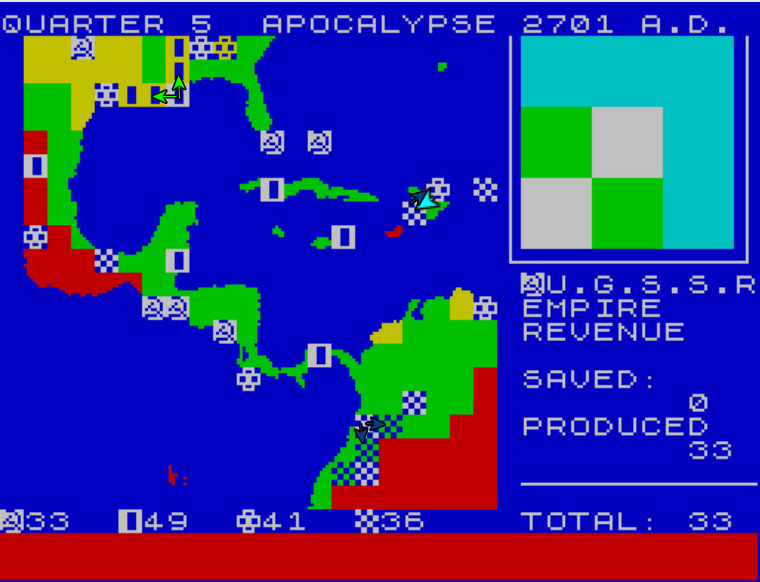
I was happy to develop peacefully but everything changed when the UGSSR attacked Houston!
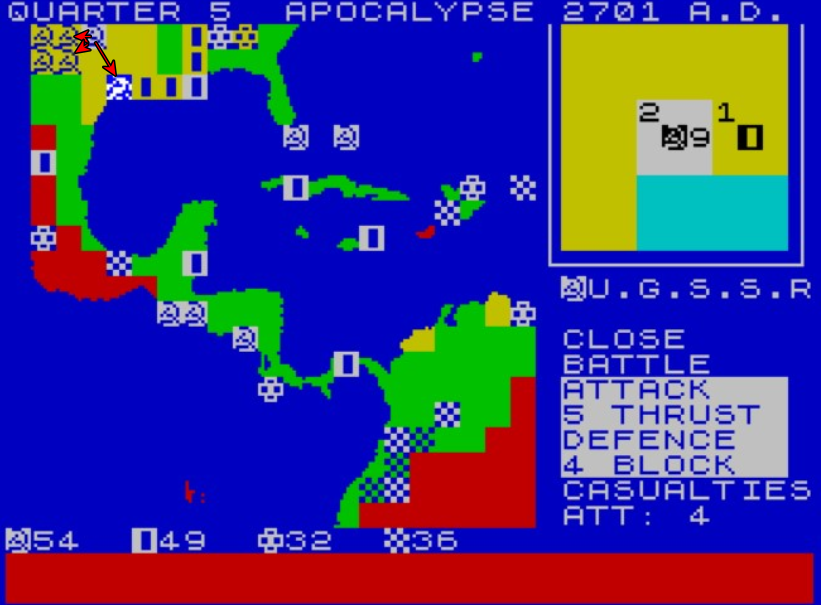
In Apocalypse, combats are solved by choosing a “strategy/commitment” for the attacker (from 1 to the number of armies attacking, maximum 9), and a “strategy” for the defenders ( from 1 to the number of units available to attack). If the number chosen by the defender exactly matches the one chosen by the attacker (=the commitment), then the attacker loses everything and the defender nothing! Otherwise, the defender loses armies corresponding to the commitment and the attacker loses armies depending on how close the defender was from guessing.

In our game, we let the computer randomly choose the attack & defensive strategies. Given cities require a minimum attack commitment of 4, a player attacking a city has at best 1 chance out of 6 of losing everything; and smaller attacks have even worse odds. Amusingly enough, the game lets you attack a city with only 4 armies, which means that the defender will automatically match your commitment (4) and the attacker will lose 100% of the time. That’s what happened to the neo-Mayans and Genar in the first turn, and in later turns they kept attacking with very low odds of success.
Back to the game. I have a significant revenue at this point, so I raise a huge army on my turn, take Houston with few losses and then distribute the survivors in urban terrain. Meanwhile, Operative Lynx and KarbonKitty carry on their fruitless island warfare, but also start grabbing some clay outside of Saint Domingue.
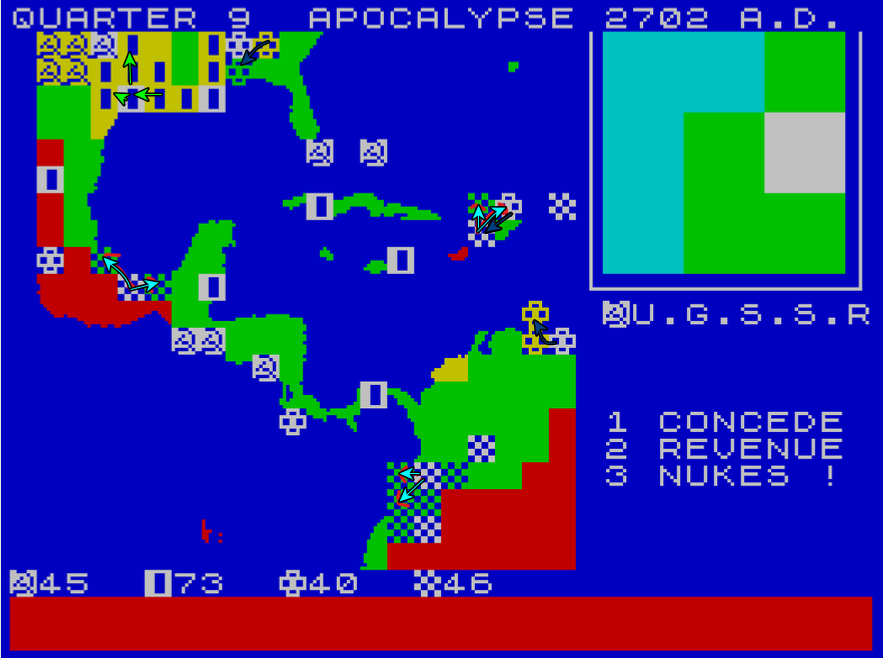
The following turn, the war carries on in Texas. The UGSSR seizes Houston once again, but I retake it, and also occupy Dallas. In my book, without any cities, the UGSSR has lost its foothold in the area…
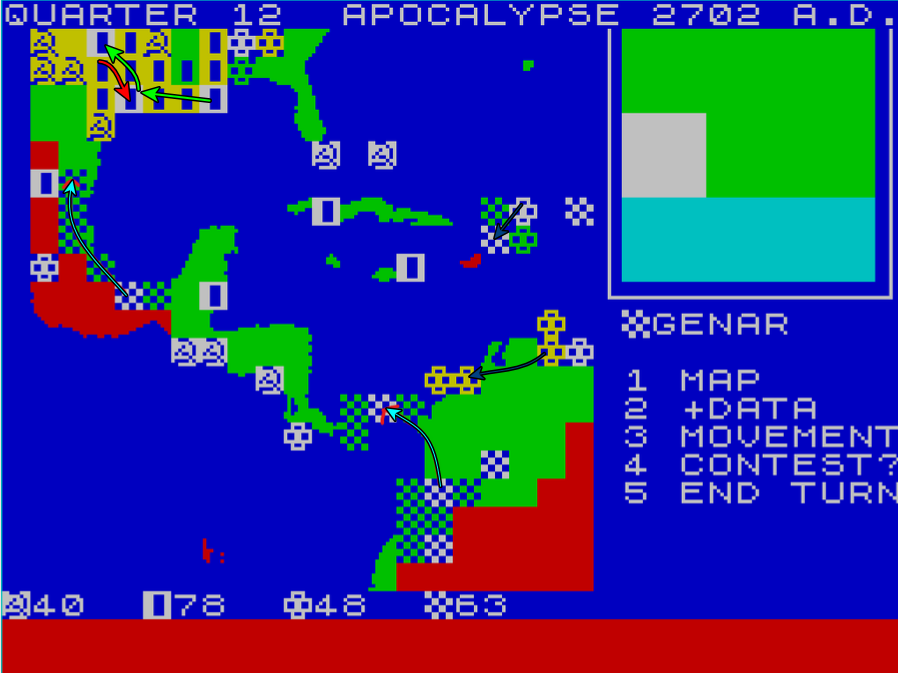
…. that’s when KarbonKitty informs us that he found out one can build units in any territory you control, not just cities! This means I must expel Dayyalu from every single tile in my area before I am rid of him, particularly because armies can move/attack up to 6 times by turn!
Suddenly, I don’t feel so good about my situation: Dayyalu’s UGSSR has a weak economy but is focusing exclusively on me in Texas, and KarbonKitty has publicly announced that he was going after me because I am the leading player.
B. Blood, beaches and radiation
Threatened by a coalition between the Genar and the UGSSR, I return to the Operative Lynx and his neo-Mayans to upgrade our “non-aggression” pact into a full-fledged alliance. I would like him to distract KarbonKitty in South America – in exchange, I will take Miami for him.
Well, that’s the plan anyway. Alas, the Random Number Generator decides otherwise as I lose almost everyone in my first assault on Miami. Dayyalu feels it is the perfect moment to propose a peace plan, but I refuse.
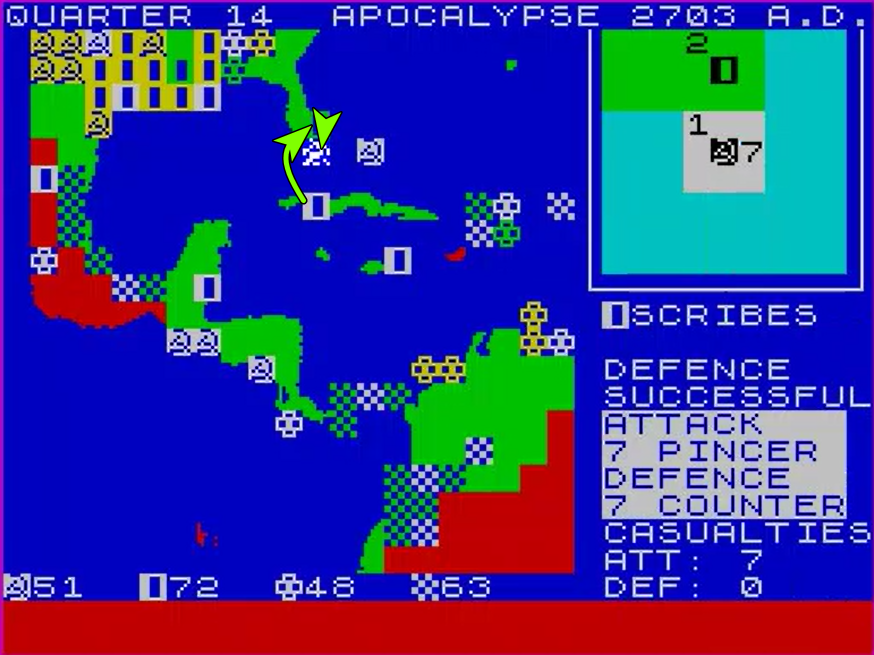
Frustrated, I change my strategy and build a small nuclear missile in Havana. At least, Operative Lynx of the neo-Mayans fulfills his part of the deal and attacks the KarbonKitty’s Genar in South America, capturing Bogota where the Genar was building its own nukes. It does not prevent the Genar from focusing on me, but it fails to take both Jamaica and Monterrey in Mexico. Dayyalu approaches me once again and tries to convince me to peace out, share Texas and focus somewhere else, but I leave him on Read.
After rejecting yet another UGSSR peace proposal turn 5, I finally get to do something decisive turn 6 when I blow up my own city Havana.
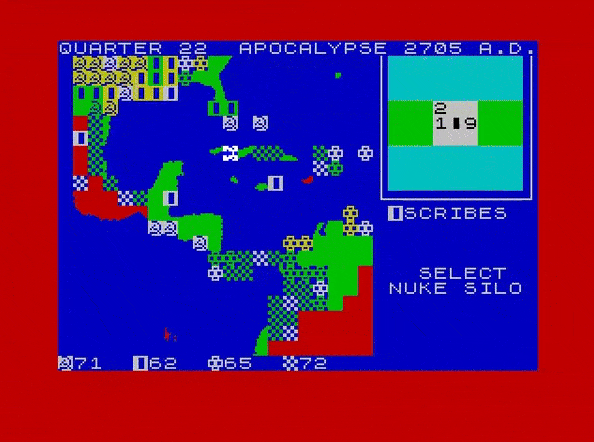
Well, of course I did not only blow up Havana. In Apocalypse, nuclear missiles blow up everything in a 3×3 square, but their range depends on the “level” of the rocket. As I had to fight for Texas, I could only invest in 1 level of nuke, so range 1: my missile sent from Havana was bound to damage Havana. It does not matter: I can recruit more armies from my position just North of Miami, which I use to immediately occupy Nassau and retake Havana. As for Miami, as per the agreement, I leave it to Operative Lynx.
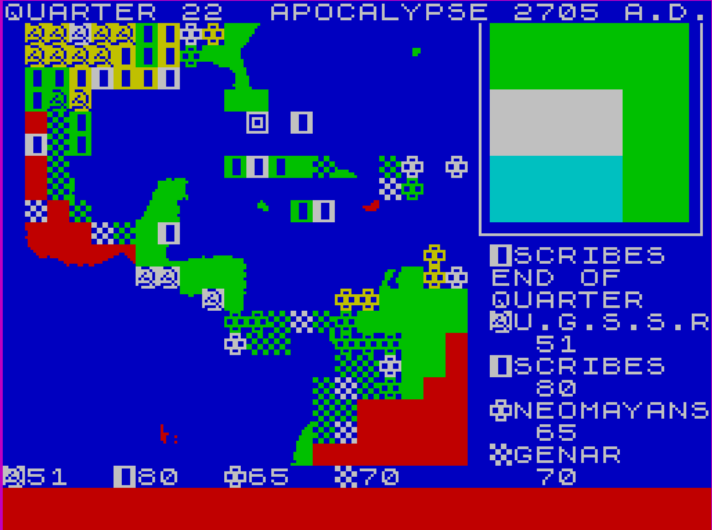
Dayyalu has lost two of its cities with no hope of recovering them, so I should be happy with my move. Yet, by the time the turn returns to me, the UGSSR has taken New Orleans and the Genar has finally taken Monterrey – all my advantage in production has evaporated.
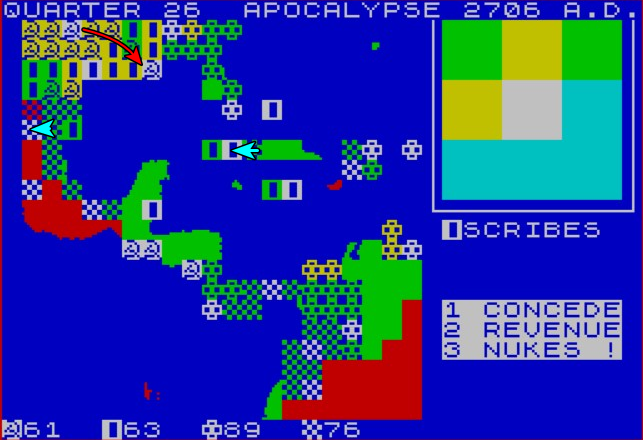
I don’t like how this two-front war is going, and I know it is going to get even worse as the Genar will certainly attack Belize next. After retaking New Orleans, I finally accept Dayyalu’s proposal. We will share Texas, with the UGSSR owning everything East of a vertical line passing between Dallas and Houston. We will still fight to “expel” units on the wrong side of the border, mostly to convince the other players that we are still fighting. One turn later, I expel the Genar from Cuba and the Genar captures Belize. With no obvious line of contact between me and the Genar, I can enjoy my first turns of relative peacetime, except for the pantomime combats the UGSSR and myself are still having in Texas.
C. Peace & Betrayal
While Operative Lynx, KarbonKitty and Dayyalu are fighting, I can rebuild a bit. I first focus on grabbing every unclaimed square within reach, including Yucatan.
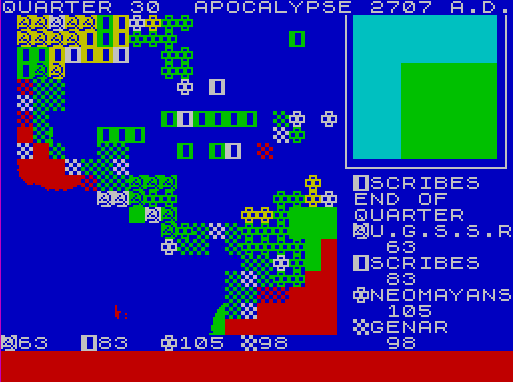
After some fighting in Yucatan, KarbonKitty reckons I am not worth the effort: we quietly peace out. I am sure my ally the neo-Mayans will be able to fend off the UGSSR and the Genar alone.
With no enemies and all freebies claimed, I focus on two things:
- Building nukes in several of my cities: Havana, New Orleans and Houston. Each of these cities can be pointed at two factions for deniability,
- Building a reserve of production points that accumulate turn after turn. When the war resumes, I want to be able to summon huge armies from thin air.
While I am enjoying the dividends of peace, the alliance between the UGSSR and the Genar manages to push back the neo-Mayas. in 2708, Oprative Lynx strikes back, decisively:
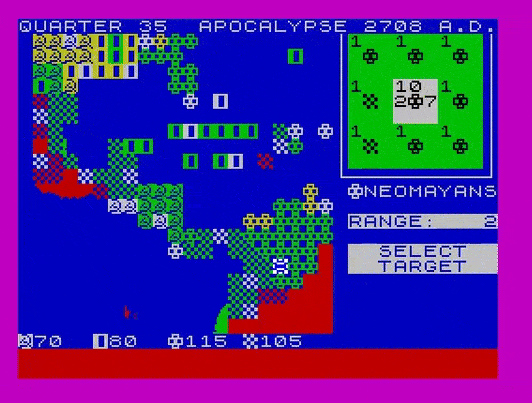
The neo-Mayas used the Genar-built nuke in Bogota to strike just between Cali and Quito, obliterating the defenders of both. Worse: there was a Genar nuclear missile in Quito, and the strike triggered a chain reaction. The nuke explodes, destroying more Genar defenders. Operative Lynx just has to occupy the now empty territory, and he becomes the absolute master of South America.

Of course, the area around Cali and Quito is now almost sterile: a tile hit by a nuclear strike almost always loses 1 in production until the end of the game and can this way reach zero production. Still, the KarbonKitty’s Genar is in trouble, because Dayyalu’s UGSSR takes the last neo-Mayan city in Central America which was [checking Google Maps] San Jose – which means Dayyalu has no more common border with the neo-Mayans.
I am in a difficult diplomatic situation: I am allied to Operative Lynx’s neo-Mayans and at peace with Dayyalu’s UGSSR. But with the fall of the San Jose, the latter will have to either betray me or the Genar, else they will have nowhere to expand. If they betray me, I don’t have such a production advantage that I can avoid a long grind, but still that would be the best-case scenario, because if they betray the Genar, then the neo-Mayas will easily crush the Genar, then the UGSSR, and then the rest of the Genar. Operative Lynx may be my ally, but I don’t want him to win.
The situation, however, can be turned into an opportunity. If I managed to destroy – in one swoop – all the UGSSR forces in Texas, then Dayyalu’s only choice would be between doing nothing (not really Dayyalu’s style) and fighting the Genar. Of course, this would mean the Genar would collapse quickly, but I would be in a better situation to fight the Operative Lynx’s neo-Mayans in the end game.
…though… there was maybe a way to create an even more favourable position relative to the neo-Mayans. Remember those nukes I mentioned?

It was time to change my dance partner. I proposed an alliance to KarbonKitty of the Genar, who was too happy to accept given his situation. As for Operative Lynx and Dayyalu, well, I did not warn them before betraying them.
I sent the first nukes against Operative Lynx in Florida:
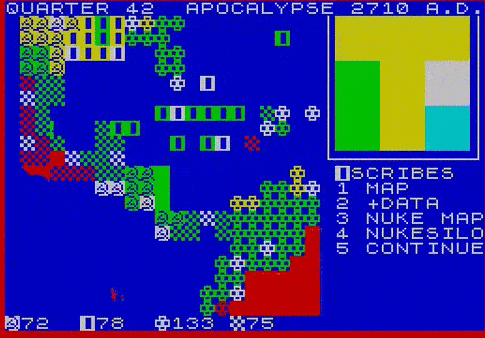
I then sent the second batch against Dayyalu in Texas:
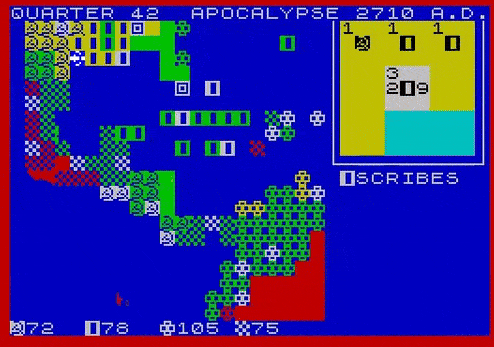
But of course, this was just an opening. For my plan to work, I have to destroy all of Dayyalu’s forces in Texas, and ideally all the neo-Mayans forces as well. It was time to tap into my currency reserve:
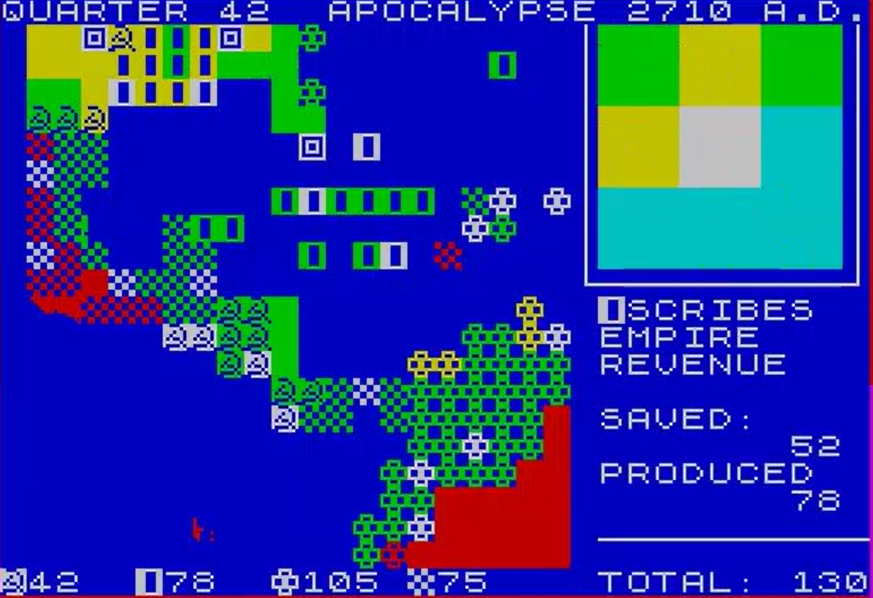
I spent it all, raising 32 armies in one turn that I added to the armies I had already built in the previous turn. This was more than enough to take 4 rural terrains (no defensive bonus) and 2 urban ones. By the end of Turn 11, I controlled everything North of Miami!
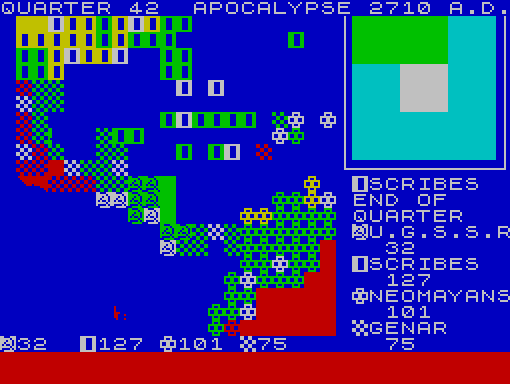
D. The final push
Both Dayyalu’s UGSSR and the Operative Lynx’s neo-Mayans took quite a hit in terms of economy, but I still don’t have that much of a decisive advantage. Therefore, my strategy hinges on the fact that KarbonKitty is not going to accept an alliance with the neo-Mayans after losing Quito and Cali – and I am indeed correct. After feigning compliance to the neo-Mayans, KarbonKitty takes its revenge by retaking Bogota! Operative Lynx, who had built a massive fleet in Port-au-Prince and occupied a part of Cuba, is caught flat-footed.
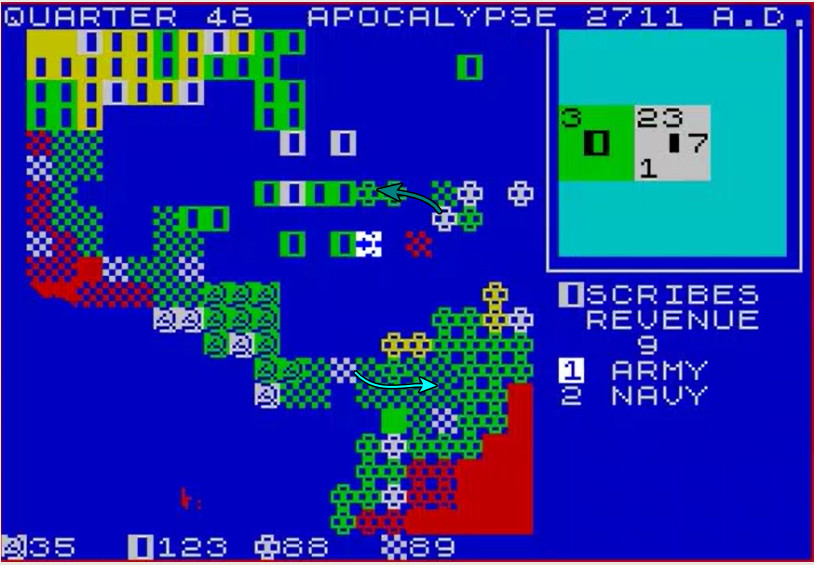
I am satisfied that KarbonKitty won’t switch sides after this, so I have only one frontline: the Caribbean islands. Naval warfare is a bit different from land warfare in ways that advantage the strongest economy even more. First, attacking a land tile from the sea is dangerous: the defender has two chances to match the attacker’s strategy. Furthermore, armies can only be embarked from cities, but cities are hard to take: at this point in the game we found out that to take a city, an attacker must remove both all the armies (in land combat) and all the fleets (in naval combat) inside – land forces can never take a city where there is at least one fleet Finally, fleets are expensive: 8 by unit, so twice as much as armies.
The neo-Mayans having a massive fleet, I ignore their islands and land directly in Venezuela!
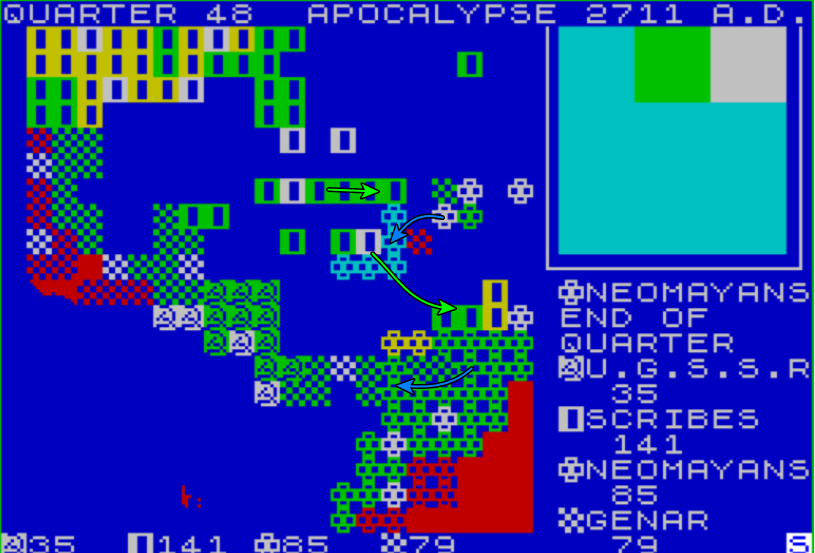
Opeative Lynx focuses on the Genar this turn, pushing them back almost to Panama, and surround Jamaica with their fleet.
Seeing the neo-Maya fleet split into small manageable chunks, I build a fleet of my own, breach the blockade and take Port-au-Prince. One turn later, as the neo-Mayans chase me from Venezuela, I seize Santo Domingo and Puerto Rico.
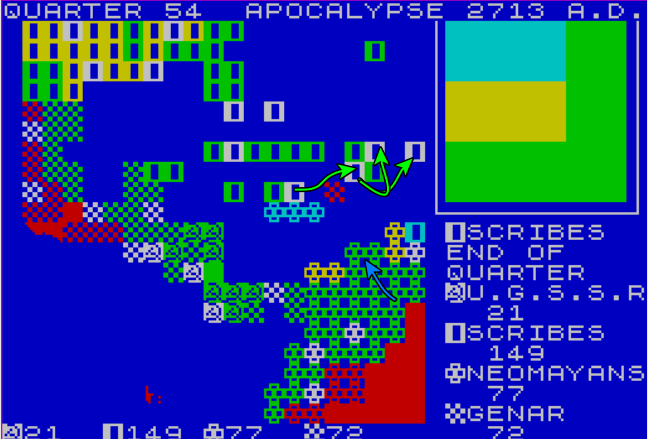
It is the end. Dayyalu and KarbonKitty are locked into a bitter war, and they sent so many nukes to each other that they reduced Central America to a barren wasteland. This leaves the neo-Mayans, and their economy is half of mine. I land in Venezuela again, and one turn later I occupy Caracas and march South, reaching the gates of Bogota:
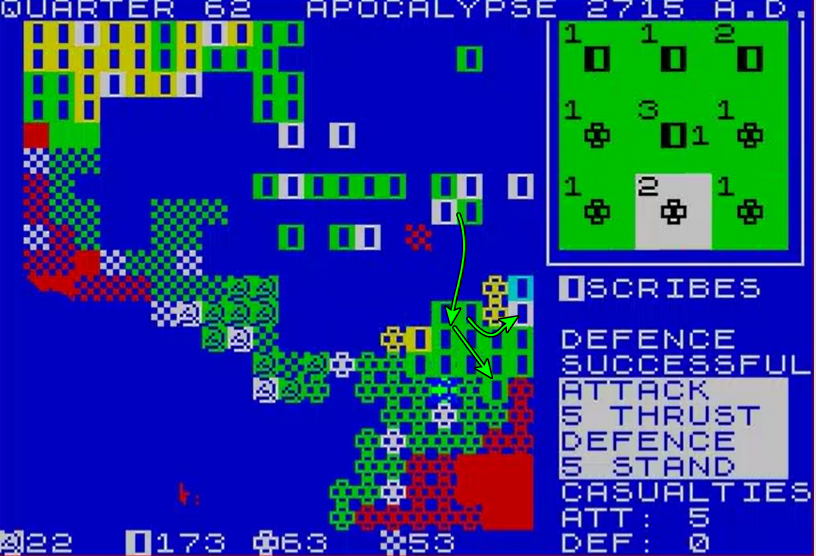
Controlling half the production points of the game, I ask the other players to resign:
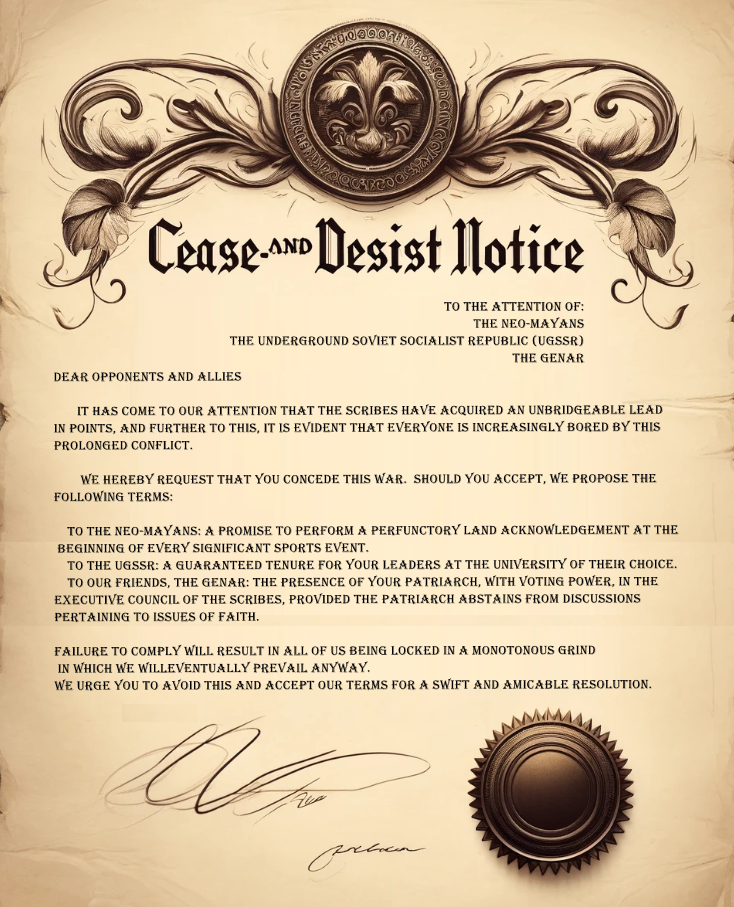
Operative Lynx and KarbonKitty desist, but Dayyalu with his 22 production points rejects my generous offer. When the neo-Mayans and the Genar surrendered, all their units disappeared, and Dayyalu immediately occupied as many empty spaces as he could. His economy soars to 56 production points.
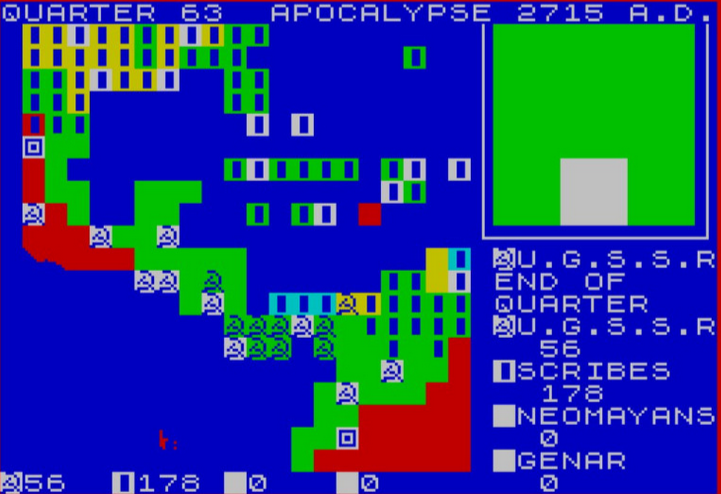
That’s not enough. With 178 in production, I can build almost 45 new armies by turn, and it does not take me long to occupy every single available tile, forcing Dayyalu to finally concede.
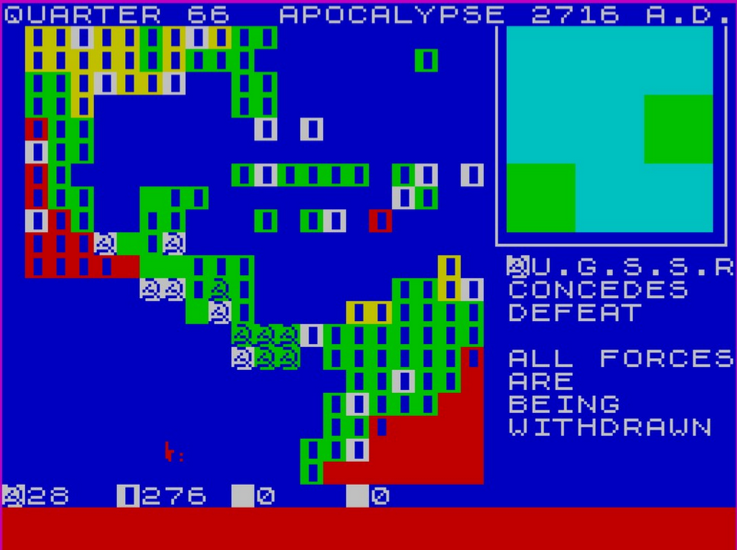
Overall, I feel I owe my victory to three factors:
- I understood the economy and the combat system one turn before the other players, giving me a small advantage that kept the UGSSR on the defensive early on,
- While I was less lucky than Dayyalu when fighting in Texas and when attacking Miami, the least lucky of us all was probably KarbonKitty of the Genar, who failed several attacks against my cities in a row. If Monterrey or worse Havana had fallen before I could strike Miami, my situation would have been desperate,
- After my betrayal, which paid off beyond my expectations, KarbonKitty remained on my side, even when it meant it would allow me to win. In-game animosity with the neo-Mayans played a role, but it is clear that the terrible UI of the game convinced KarbonKitty that the sooner we would end this game, the better for everyone.
I probably ruined my future diplomatic relationships forever by exposing my own double-dealing, but I won, so it was worth it. This article is now way too long, so I will release the Ratings and Review separately, but soon!